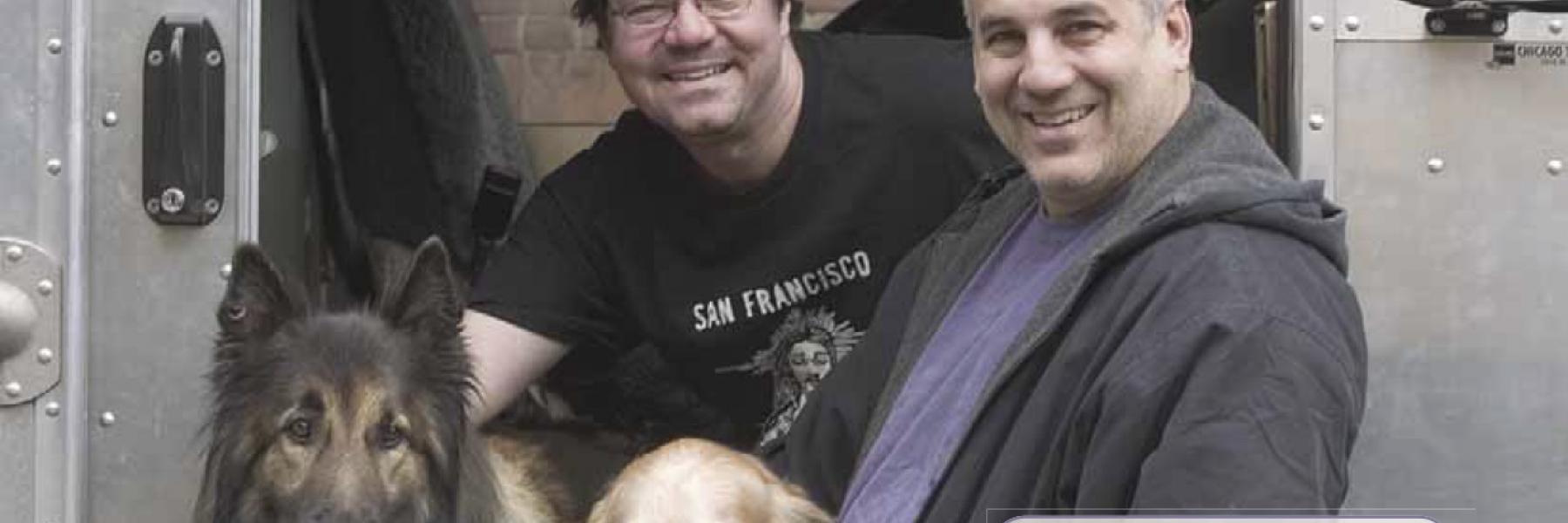
The article "The Silver Van" first appeared in the July/August 2005 issue of Positively Aware magazine and is about the Chicago Recovery Alliance and co-founder Dan Bigg, 59, who died at his home on Tuesday, August 21. The Cook County medical examiner’s office said the cause of death remains undetermined pending further tests. According to an article in the Chicago Tribune, "as a result of Bigg’s efforts, friends and colleagues said, thousands of people who would have died from infections or overdoses are still alive — a flesh and blood legacy of the “harm reduction” philosophy Bigg helped to popularize.
You can also view the article in PDF form from the original print version which includes photos by Russell McGonagle.
It’s a typical mid-May Sunday afternoon in Chicago—unseasonably cool with brief glimpses of sunlight on an otherwise gray, cloudy day. The setting is the infamous “Blood Alley”, a narrow, nondescript, one-way street lined with turn of the century one- and two-story brick buildings, reminiscent of a Universal studio lot.
On any given Sunday, you’ll find the instantly recognizable silver van operated by Chicago Recovery Alliance (CRA) parked on the street. Staff ed by both paid workers and volunteers, the van is a mobile operation frequented by injection drug users (IDUs). Here, they can exchange their used needles for new, sterile syringes.
They can also get cookers, cotton, sterile water/saline, alcohol pads and ties, as well as hepatitis A and B vaccinations, HIV tests, counseling, information, and condoms. The van operates at diff erent times and days at various locations throughout the city.
On this particular day, sterilization kits, neatly gift -wrapped in the Sunday comics page of the newspaper, are stacked off to one side, available on a first-come, first-served basis. A basket full of muffins and pastries disappears quickly.
Tucker and Sammy, two mixedbreed dogs who have just come from the dog beach at Montrose Harbor, lie quietly on the floor of the van. They appear disinterested and nonplussed as people begin trickling in. A few potential customers hesitate and stare from halfway down the block—a worker goes out to meet them. They glance warily in my direction—I appear conspicuously out of place with my notepad and photographer in tow.
They step into the van and are greeted with hello. They bring along their syringes, some in boxes, others carefully protected and wrapped in plastic bags, and place them in the sharps container. One 62-year-old gentleman comes in with a large, silver Heft y garbage bag, slightly used, filled with box after box of used syringes. “I was a latebloomer,” he remarks dryly.
First-time clients are given a unique code, which is printed on a card. Then, each time they return they display the card, and their number is logged. They also are asked their zip code, drug of choice (heroin, meth, crack, steroids, etc.), and what type of syringes they need (intramuscular or intravenous). They are given as many as they want, no questions asked.
The ID card with the unique identifier helps CRA collect and track pertinent data. In addition, if the person carrying syringes is ever stopped or questioned by the police, in theory they should be able to simply present the card, and not be hassled for possession.
I meet Al, an African American man in his early 50’s. He recounts an episode a couple of years ago when he and fi ve others were shooting up together. “They just started droppin’, like they were in the desert, dyin’ of thirst,” he recalled. All five of his companions had begun to overdose.
Al was one of the first people trained by CRA on the use of naloxone (Narcan), which is a pure antidote to heroin. Remembering what needed to be done, he immediately began to fill five syringes with naloxone and “hit ‘em anywhere with the damn shit”, jamming the needles into them, one by one. Had he not, they probably would have all died.
Dan Bigg, executive director of CRA, describes an incident in which he administered naloxone to a woman who had been brought in by her boyfriend after overdosing. “She had this shirt on that had buttons on it, and you had to roll it up or whatever, so I just said ‘fuck it’ and went right through the shirt [with the needle].”
Her pulse was strong, but although her heart was still beating, she had stopped breathing. Without oxygen, she would soon die. While still in the passenger seat of the car, her boyfriend leaned the seat back, and Dan started to breathe for her. Several minutes later, her boyfriend took over. After one or two puff s of air from him, she awoke gently, and slowly looked around, not knowing where she was or why she was even there.
“This woman woke up and she didn’t believe what we were saying,” exclaims Bigg. He pointed to the boyfriend, a tough, Polish kid, who had tears streaming down his face. They continued describing to her what had just happened.
As it turned out, she had been in the van two or three months earlier, and had overheard someone talking about how they had used naloxone on a person who had OD’d. “Hey,” she had mentioned to him at the time, “they’re doing some overdose thing over at the van.” The boyfriend, remembering what she had told him several months earlier, brought her in when she began to OD.
So why didn’t he take her to an emergency room instead of the CRA van? “The bottom line is, if your relationship is spent fearing being thrown into a cell by a huge group of people, all of a sudden you’re cautious of just about everything,” states Bigg.
Between January 2000–2001, 466 people in Cook County died of a heroin overdose. Since then, over 300 lives have been saved by people like Al, trained in the administration of naloxone. While naloxone has been around for nearly 40 years in the medical setting, it hasn’t been readily available to the public, until recent efforts here by CRA.
“The long and the short of it is, there’s not too much cooperation around health issues [when it comes to drug use]. That’s why we thought, this needs to be in the hands of people who need it immediately, because timing is everything,” continues Bigg. “Just like epinephrine and glucagons in emergency medicine.”
Gus Grannan, a volunteer for CRA, is a laid-back, soft -spoken guy who was born and raised in Detroit. He got his degree at Wayne State University, and continued his graduate studies at the University of North Carolina-Chapel Hill. He moved to Chicago in 1998, and now works for the University of Chicago Library. “I’d like to be doing this full-time,” says Grannan, “but right now I just volunteer.” He dons a black T-shirt with white lettering that spells out “San Francisco Needle Exchange.” On it is an image of what appears to be the face of Jesus, with dreadlocks made of syringes, creating a surreal, halo-like effect.
Gus proceeds to explain the purposes of all the various items in the van. When he gets to the packets of ascorbic acid, he explains, “The heroin in Chicago will dissolve on its own in water because it’s slightly acidic. But crack’s a base, that’s what it is, chemically, it’s base, [a different pH], so if you put it in water it’s not going to dissolve [in order to inject]… if you add enough ascorbic acid to it, it will neutralize it and it will dissolve [in water].
“We also vaccinate for hep A & B. There is no vaccine for C, but once you have hep C, and you contract A or B, it might cause even more serious damage to your liver.”
It should be noted that people who inject drugs, are HIV-positive, or at risk for HIV should vaccinate against hep A and B, regardless of whether or not they have hep C.
Aizhan, a 37-year-old woman from Kazakhstan, stops by to visit and say hello. She’s a petite, bubbly, energetic woman, whose eyes twinkle and face beams with an infectious grin. She has subtle, Asian features and a thick, Russian accent, but speaks English surprisingly well. She works with IDU’s in her own country, and is here in the U.S. on a fellowship, studying at DePaul University.
In Kazakhstan, as in most of the newly independent states freed from Soviet control, drug abuse, particularly heroin, is a huge problem. Between 70 and 80 percent of HIV infections can be attributed to injecting drug users or their sexual partners. Most of the world’s heroin comes from nearby Afghanistan, but in many surrounding places, including Moscow, syringe exchange is illegal, further exacerbating the problem and fueling the epidemic.
Through the efforts of Aizhan and others, and in conjunction with organizations such as the Open Society Network, they are beginning to reach out and educate injection drug users, using the same harm reduction philosophy that CRA is based upon. Aizhan would someday like to create an advocacy and methadone program in her own country.
But today, Aizhan has come by to let Bigg know how much she appreciates the work that he is doing. Back in Kazakhstan, they’ve asked her what she has learned so far. She tells them what she’s learned through her work in the States and with CRA, and from Bigg in particular.
“I told them, three main things that I learned from you: Leadership… collaboration…and financial stability, which gives everybody possibilities.
“I love this country, I love America, I really do,” Aizhan states emphatically. “But my country, I love more. I love my people. I want to help my drug users.”
For more information on Chicago Recovery Alliance, go to anypositivechange.org


